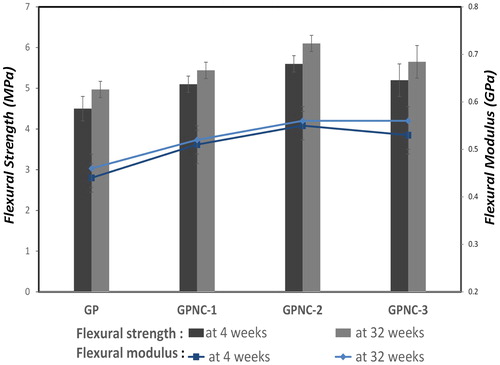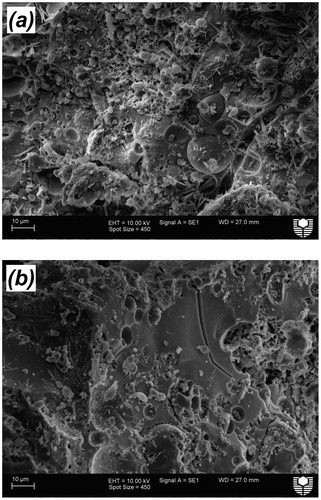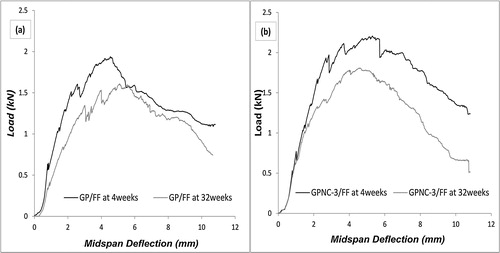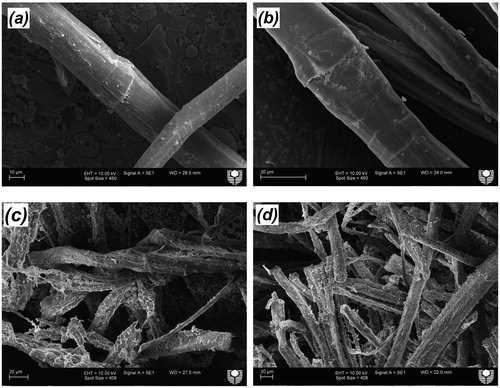 ?Mathematical formulae have been encoded as MathML and are displayed in this HTML version using MathJax in order to improve their display. Uncheck the box to turn MathJax off. This feature requires Javascript. Click on a formula to zoom.
?Mathematical formulae have been encoded as MathML and are displayed in this HTML version using MathJax in order to improve their display. Uncheck the box to turn MathJax off. This feature requires Javascript. Click on a formula to zoom.Abstract
The main concern of using natural fibres as reinforcement in geopolymer composites is the durability of the fibres. Geopolymers are alkaline in nature because of the alkaline solution that is required for activating the geopolymer reaction. The alkalinity of the matrix, however, is the key reason of the degradation of natural fibres. The purpose of this study is to determine the effect of nanoclay (NC) loading on the mechanical properties and durability of flax fabric (FF) reinforced geopolymer composites. The durability of composites after 4 and 32 weeks at ambient temperature is presented. The microstructure of geopolymer matrices was investigated using X-ray diffraction (XRD), Fourier transform infrared spectroscopy (FTIR) and scanning electron microscopy (SEM). The results showed that the incorporation of NC has a positive impact on the physical properties, mechanical performance, and durability of FF reinforced geopolymer composites. The presence of NC has a positive impact through accelerating the geopolymerization, reducing the alkalinity of the system and increasing the geopolymer gel.
1 Introduction
Ordinary Portland Cement (OPC) is believed to be responsible of generating 5% of the global carbon dioxide emission [Citation1]. One of the most attractive alternatives of OPC is geopolymer binder due to its comparable mechanical properties to the OPC. The development of geopolymer concrete is not only important because they are environmental friendly materials, but also due to their wide range of raw waste materials to produce worthy construction matrices, resulting in low cost material with similar mechanical properties to that of cement concrete [Citation2]. Geopolymers are produced by activating a solid aluminosilicate source such as coal derived fly-ash, meta-kaolin and slag with alkaline solutions, amorphous networks of tetrahedral SiO4 and AlO4 connected by sharing oxygen atoms [Citation3]. The formation of geopolymer gel can be described by Eq. Equation(1)(1)
(1) [Citation3].
(1)
(1)
Fig. 1 X-ray diffraction patterns of geopolymer and geopolymer nanocomposites at: (a) 4 weeks; (b) 32 weeks [legend: M = mullite, Q = quartz and T = trona].
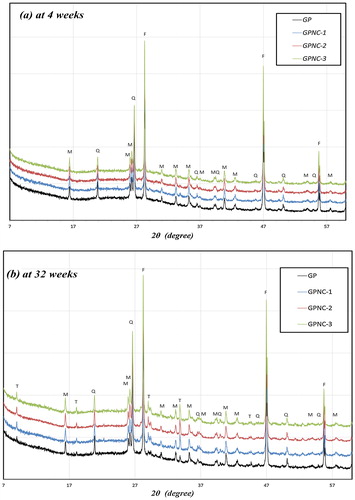
Hitherto, nanomaterials have received increased attention in geopolymer and cement research; especially in producing nanocomposites that possess superior mechanical properties [Citation4 Citation2013;Citation6]. Several kinds of nanomaterials have been incorporated efficiently in geopolymer pastes. For instance, it has been found that nano-silica and nano-alumina particles have the ability to reduce the porosity and water absorption of geopolymer matrices [Citation6]. In another study [Citation7], nano-alumina and nano-silica particles have been incorporated in geopolymer matrices giving them higher mechanical performance. The nanoparticles are not only acting as fillers, but also enhancing the geopolymeric reaction. A further study on the effect of adding carbon nanotubes (CNT) to flyash-based geopolymer has shown an increase in the mechanical and electrical properties of geopolymer nano-composites when compared to the control paste [Citation8]. Wei and Meyer reported the properties of cement/nanoclay composites, where the nanoparticles reduce the porosity of cement matrices, as well as improve the strength of cement matrix through pozzolanic reactions [Citation9]. Farzadnia et al. [Citation10] reported that incorporation of 3 wt% halloysite nanoclay into cement mortars increased the compressive strength by up to 24% compared to the control sample. In a previous study, we investigated the effect of nanoclay (Cloisite 30B) on the mechanical and thermal properties of geopolymer composites [Citation11]. Nanoclay particles were found to help developing denser geopolymer matrices, thereby producing geopolymer with superior mechanical performance.
Despite the potential improvement of properties of geopolymers, the geopolymer matrix still suffers from brittle failure readily under applied force and generally exhibits low mechanical strength [Citation12,Citation13]. One way to resolve this limitation is through utilizing natural fibres to fabricate fibre-reinforced geopolymer composites. The advantages of using natural fibres in composites include the low density, flexibility and the high specific modulus [Citation14,Citation15]. Cotton fibres and fabrics have been used to improve the fracture toughness and mechanical performance of geopolymer composites [Citation16,Citation17]. Also, flax and wool fibres have presented positive effects when incorporated in geopolymer matrices; they significantly improved the mechanical properties of the natural fibre reinforced geopolymer composites [Citation1,Citation18]. In our previous work, geopolymer composites were reinforced with woven flax fabric and tested for mechanical properties such as flexural strength, flexural modulus, compressive strength, hardness, and fracture toughness. The results showed that all mechanical properties were improved by increasing the flax fibre contents, and showed superior mechanical properties over the pure geopolymer matrix [Citation19]. In a further study, geopolymer matrices were reinforced with a combination of nanoclay (NC) and flax fabrics (FF) and it was found that the addition of NC to geopolymers improved the adhesion between the natural fibres and the matrices due to the high amount of geopolymer gel formed, resulting in higher mechanical results [Citation20].
However, there are concerns in utilizing natural fibres in alkali-based matrices. The main concern is regarding the long-term durability of natural fibre reinforced composites. Natural fibres can be degraded and damaged in high-alkaline environment; thereby adversely affecting the mechanical properties and durability of the composites [Citation21 Citation2013;Citation23]. Natural fibre degradations in alkaline environments was studied by Gram [Citation24] and he described the degradation mechanism as the decomposition of hemicellulose and linen which leads to the splitting of natural fibres into micro-fibrils [Citation24]. This effect has been observed using SEM in the case of jute fibres in cement matrix, where the natural fibres split-up and fibrillised resulting in reduction in the tensile strength of jute fibres by 76% [Citation25]. To reduce the degradation impact, nanoparticles can play an important role. The effect of nanoclay particles on the durability of flax fibres reinforced cement composites at 28 days and after 50 wet/dry cycles has been investigated by Aly et al. [Citation21]. Samples loaded with 2.5 wt% nanoclay particles showed lower deterioration in the flexural strength when compared to its counterpart control samples. This was attributed to the effect of nanoparticles in reducing the degradation of flax fibres.
According to the best of knowledge of authors, no study has been reported on the durability of natural fibres in geopolymer matrices. The presence of nanoclay particles is anticipated to reduce the degradation of natural fibres by consuming certain amounts of alkaline solution, which reduces the alkalinity of the medium. Nanoclay is also expected to produce higher amount of geopolymer gel, increases in matrix density, fibre-matrix adhesion, and the concomitant improvement in mechanical properties. In this paper, in order to improve the durability and reduce the degradation of flax fabric (FF) in geopolymer composites, geopolymer matrices were modified by the addition of nanoclay (NC) particles. This study presented the effect of different loadings of nanoparticles on the durability and mechanical properties of FF-reinforced geopolymer nanocomposites. The medium to long term durability of all samples has been discussed in terms of flexural strength obtained at 4 and 32 weeks. The microstructure was investigated using X-ray diffraction, Fourier transform infrared spectroscopy (FTIR) and scanning electron microscopy (SEM).
2 Experimental procedure
2.1 Materials
Low-calcium flyash (ASTM class F) with specific gravity 2.1 obtained from the Eraring power station in NSW was used to prepare the geopolymeric nano-composites. The alkaline activator for geopolymerisation was a combination of sodium hydroxide solution and sodium silicate grade D solution. Sodium hydroxide flakes with 98% purity were used to prepare the solution. The chemical composition of sodium silicate used was 14.7% Na2O, 29.4% SiO2 and 55.9% water by mass.
Flax fabric (FF) and nanoclay (Cloisite 30B) were used for the reinforcement of geopolymer composites. The fabric, supplied by Pure Linen Australia, is made up of yarns with a density of 1.5 g/cm2. The nanoclay (NC) with specific gravity of 1.98 has been provided by Southern Clay Products, USA.
To prepare the geopolymer pastes, an alkaline solution to fly ash ratio of 0.75 was used and the ratio of sodium silicate solution to sodium hydroxide solution was fixed at 2.5. The concentration of sodium hydroxide solution was 8 M, which was prepared and combined with the sodium silicate solution one day before mixing.
2.2 Preparation of geopolymer nanocomposites
The nano-clay particles (NC) were added to the flyash at the loadings of 1.0, 2.0 and 3.0% by weight. The flyash and nanoparticles were first dry mixed for 5 min in a covered mixer at low speed and then mixed for another 10 min at high speed until homogeneity was achieved. The alkaline solution was then added slowly to the flyash/nanoparticles mixture in a Hobart mixer at a low speed until the mixture became homogeneous, followed by further mixing for another 10 min on high speed. The resultant mixture was then poured into wooden moulds. The wooden moulds were then placed on a vibration table for 2 min before they were covered with a plastic film and cured at 80°C for 24 h in an oven before demolding.
2.3 Preparation of FF-composite and nanocomposites
Similar mixtures were prepared to produce the FF-nanocomposites. Four samples of geopolymer pastes reinforced with ten layers of FF (see ) were prepared by spreading a thin layer of the paste in a well-greased wooden mould and carefully placing the first layers of FF on it. The fabric was fully saturated with the paste by a roller, and the process repeated for ten layers; each specimen contained a different weight percentage of nanoclay particles. The samples were then left under heavy weight (20 kg) for 1 h to reduce entrapped air inside the samples. All samples were covered with plastic film and cured at 80°C for 24 h in an oven before demoulding. They were then dried under ambient conditions for 28 days.
Table 1 Formulation of samples. Each samples is a mix of: 1.0 kg Eraring flyash, 214.5 g sodium hydroxide (8 M) and 535.5 g sodium silicate.
All samples were then categorized in two series. In the first series, samples were cured under ambient conditions to be tested after 4 weeks, and the samples of second series were stored in the same condition for 32 weeks. The formulation of samples is given in .
2.4 Characterization
The samples were crushed and ground to fine powder. They were then measured on a D8 Advance Diffractometer (Bruker-AXS, Germany) using copper radiation and a LynxEye position sensitive detector. The diffractometer were scanned from 7.5° to 60° using a scanning rate of 0.5°/min. XRD patterns were obtained by using Cu kα lines (k = 1.5406 Å). Crystalline phases were identified using software EVA version 11. The chemical compositions of NC were analyzed using X-ray fluorescence (XRF). XRF was outsourced to a commercial laboratory (Bureau Veritas, Perth). An FTIR scan was performed on a Perkin Elmer Spectrum 100 FTIR spectrometer in the range of 4000–500 cm−1 at room temperature. The spectrum was an average of 32 scans at a resolution of 2 cm−1, corrected for background. The microstructures of geopolymer composites were examined using Zeiss Neon focused ion beam scanning electron microscope (FIB-SEM). The specimens were mounted on aluminium stubs using carbon tape and then coated with a thin layer of platinum to prevent charging before observation.
2.5 Physical and mechanical properties
Measurements of bulk density and porosity were conducted to define the quality of geopolymer nanocomposite. Density of samples with volume
and dry mass
was calculated using Eq. Equation(2)
(2)
(2) :
(2)
(2)
The value of apparent porosity (Pa) was determined using Archimedes’ principle in accordance with the ASTM Standard (C-20) [Citation26]. Pure geopolymer and nano-composite samples were immersed in clean water, and the apparent porosity (Pa) was calculated using Eq. Equation(3)(3)
(3) :
(3)
(3) where ma is mass of the saturated samples in air, and mw is mass of the saturated samples in water.
A LLOYD Material Testing Machine (50 kN capacity) with a displacement rate of 0.5 mm/min was used to perform the mechanical tests. Rectangular bars of 60 × 18 × 15 mm3 were cut from the fully cured samples for three-point bend test with a span of 40 mm to evaluate the flexural strength and modulus. Five samples of each group were used to evaluate the flexural strength and flexural modulus of geopolymer composites. The values were recorded and analyzed with the machine software (NEXYGENPlus) and average values were calculated. The flexural strength (σF) was determined using the equation [Citation27]:(4)
(4) where Pm is the maximum load, S is the span of the sample, D is the specimen width, and W is the specimen thickness.
Values of flexural modulus (Ef) were computed using the initial slope of the load displacement curve (ΔP/ΔX) using the equation [Citation27]:(5)
(5)
3 Results and discussion
3.1 Density and porosity
The results of porosity and water absorption of geopolymer paste and geopolymer nano-composites are shown in . Geopolymer nanocomposites revealed denser matrices and lower porosities when compared to the control sample. The addition of NC has increased the density and reduced the porosity of geopolymer nano-composites when compared to control geopolymer paste. The optimum addition was found as 2.0 wt% of NC, which increased density by 11.4% and reduced the porosity by 7.2% when compared to the control paste. This implies that the nanoparticles played a pore-filling role to reduce the porosity of geopolymer composites. However, adding excessive amounts of NC increased the porosity and decreased the density of all samples due to agglomeration of NC particles [Citation11]. This finding is comparable with the study where the porosity of cement paste is decreased due to addition of 1.0% wt. of NC to cement paste; however, the porosity is increased because of the agglomeration effect when more nanoparticles were added [Citation28].
Table 2 Density and porosity for pure geopolymer and geopolymer nano-composites.
3.2 X-ray fluorescence (XRF) and X-ray diffraction (XRD)
The chemical composition and loss on ignition of flyash and NC are shown in . Flyash and NC contain, in addition to silica and alumina, Fe2O3, CaO, K2O, Na2O, MgO and TiO2.
Table 3 Chemical compositions of flyash and nanoclay (wt%).
The XRD spectra of pure geopolymer and geopolymer nanocomposites at 4 and 32 weeks are shown in (a–b) , respectively. The crystalline phases were indexed using powder diffraction files (PDFs) from the inorganic crystal structure database (ICSD). The diffraction patterns of the samples demonstrate some crystalline phases that were indexed distinctly: quartz [SiO2] (PDF 00-046-1045) and mullite [Al2.32Si0.68O4.84] (PDF 04-016-1588). Quartz and mullite crystalline phases can be seen in all samples. According to Rickard et al. quartz and mullite are the main crystalline content of the Eraring flyash, and hence they are stable and unreactive in the alkaline environment. At 32 weeks, a new crystalline phase, trona [Na3H(Co3)2.2H2O] (PDF 00-029-1447), appears on the surface of geopolymer aged samples. Trona belongs to soda minerals group, which could be formed by the reaction of sodium hydroxide with water and carbon dioxide according to the chemical reaction [Citation29]:(6)
(6)
The amorphous broad phase generated between 2θ = 17° and 30° for all samples reveals the reactivity of geopolymers. It is known that the amorphicity degree remarkably influences the mechanical properties of geopolymers. When the amorphous content is higher, the strength of geopolymers is similarly higher [Citation30]. In previous study, it has been shown that the addition of nanoclay particles to geopolymer pastes increased the amorphous content of geopolymer nanocomposites, resulting in denser matrices and superior mechanical performance [Citation11].
3.3 FTIR observation
FTIR spectra of pure geopolymer and geopolymer nanocomposite at 4 and 32 weeks are shown in (a–b) . The FTIR spectra of all samples shows a strong peak at ∼1000 cm−1 which is attributed to Si–O–Si and Al–O–Si asymmetric stretching vibrations, which is the identification peak of the geopolymerisation [Citation31,Citation32]. A broad peak in the region around 3400 cm−1 indicates that the OH group is present attached to different centres (Al, Si) and free water [Citation33,Citation34]. The absorbance peak at 1640 cm−1 is also attributed to the (OH) bending vibration [Citation35]. At 32 weeks changes have occurred, two peaks at 1420 and 1480 cm−1 appear indicating the presence of sodium carbonate; this was formed due to the atmospheric carbonation on the matrices surfaces which confirms the XRD results [Citation29]. During the ageing period the reaction has carried on at a low rate consuming more OH groups and forming stronger material. The water content decreased to some equilibrium level during this period resulting in lower broad peak at 3400 cm−1.
3.4 Flexural strength of geopolymer nanocomposites
The effect of ageing on the flexural strength and modulus of geopolymer matrices and nanocomposites is shown in . Overall, the incorporation of nanoclay into the geopolymer composite led to noteworthy improvement in the mechanical strength at all ages. At 4 weeks, the flexural strength of geopolymer nanocomposite containing 1.0, 2.0 and 3.0 wt.% NC was increased by 13.3, 24.4 and 15.5% respectively, while the flexural modulus improved by 16, 25 and 20%, respectively compared to the control sample. This enhancement noticeably shows the value of NC in supporting geopolymer reaction and filling the micro pores in the matrix [Citation11 Citation2013;Citation28]. Thus the microstructure of geopolymer nanocomposite is denser than the pure matrix, especially in the case of incorporating 2.0 wt.% NC, which is evident from its higher flexural strength and modulus. However, at 32 weeks, the flexural strength of nanocomposites increased slightly compared to their values at 4 weeks. For instance, the flexural strength of GPNC-2 nanocomposite improved from 5.6 to 6.1 MPa by about 9% increase. This slight improvement in the mechanical performance could be attributed to the slow reaction of free silica and alumina in the presence of Na+ ions during the ageing period [Citation36,Citation37]. In similar study, Hakamy et al. [Citation23] reported that flexural strength of cement pastes containing 1.0% calcined nanoclay particles improved from 7.2 to 8.2 by about 7% after 236 days compared to its strength at 56 days. SEM images of the microstructure at 32 weeks of geopolymer paste and the geopolymer nanocomposite containing 2.0 wt.% NC are shown in (a–b) . For geopolymer matrix, a displays more pores showing a weak microstructure. On the other hand, b shows the SEM micrograph of GPNC-2 nanocomposite matrix, which is different from that of pure matrix, the microstructure is denser and more compact with fewer pores and more geopolymer gel.
3.5 Flexural strength of flax fabric reinforced geopolymer nanocomposites
The effect of ageing on the flexural strength and modulus of FF-reinforced geopolymer nanocomposites at 4 and 32 weeks is shown in . The incorporation of nanoclay into matrices led to enhancement in the flexural strength of all reinforced nanocomposites. For example, at 4 weeks, the flexural strength and modulus of GPNC-2/FF increased by 32.4% and 5.2%, respectively when compared to GP/FF composite. However, all composite showed reduction in the mechanical strength after 32 weeks. (a–b) shows the effect of ageing on the load-midspan deflection behaviour of GP/FF composites and GPNC-3/FF nanocomposites. The “ductile” behaviour can be observed in both composites with and without NC, with higher load capacity (about 29% increases) in the composite containing NC. It was observed that ductile behaviour is adversely affected and bending stresses are reduced due to degradation process. This decrease was attributed to the lignin and hemicellulose deterioration of flax fibre in matrix by Na+ ions attack and brittleness of the natural fibres due to the mineralization of fibre cell wall in geopolymer pastes [Citation38 Citation2013;Citation40]. In general, all natural fibres suffer various degree of deterioration when exposed to alkaline environment [Citation41]. This degradation in alkali matrices ultimately led to weaken the fibre–matrix bonding, and consequently reduced the mechanical performance of geopolymer composites. The flexural strength of GP/FF composite dropped to 23.0% of the initial strength at 4 weeks, whereas the flexural strength of GPNC-1/FF, GPNC-2/FF and GPNC-3/FF nanocomposites reduced by about 14.4%, 13.7% and 13.5% compared to its value at 4 weeks. Based on this outcome, it can be concluded that the reduction in the mechanical performance for nanocomposites was less than the reduction of control sample composite after 32 weeks ageing period. This may be attributed to the fact that nanoclay particles consume amounts of the alkaline solution thus reducing the alkalinity of the medium, and producing higher amount of geopolymer gel, which hence enhances the density of the matrices and the fibre–matrix adhesion [Citation20]. In a similar study, the effect of calcined nanoclay on the durability of hemp fabric reinforced cement nanocomposites and the degradation of hemp fibres are reported [Citation23], the nanoparticles were found to improve the durability and reduces the degradation of hemp fibres. In another investigation, Aly et al. [Citation21] reported that the addition of nanoclay and waste glass to cement mortar could improve the durability and mitigate the degradation of flax fibres implemented in the composites by reducing the alkalinity of the matrix. Filho et al. [Citation40] investigated the durability of sisal fibre reinforced mortar with the addition of metakaolin at 28 days and after 25 wet/dry cycles. They observed that the flexural strength of metakaolin composites decreased by 23% when compared to its control composites at 28 days. They reported that 50% metakaolin replacement significantly prevented the sisal fibres from the degradation in cement matrix. In the current investigation, the NC effectively prevented the flax fabric degradation by reducing the alkalinity of the matrix through geopolymer reaction. Thus, the degradation of flax fibres in nanocomposite was mostly reduced and the FF-nanocomposite matrix interfacial bonding was typically improved. (a–b) shows the changes in the fibres surface in GP/FF and GPNC-2/FF at 4 weeks. The fibres look more regular and free of any signs of degradation in both cases. After 32 weeks, however, the fibres extracted from control specimen (c) reveal signs of degradation and the fibrils are clearly splitting up, which influence the flexural strength of the composite, whereas the fibres extracted from GPNC-2/FF after ageing period (d) do not present signs of significant damage.
Fig. 5 Flexural strength and modulus of flax fabric reinforced geopolymer composites and nanocomposites at 4 and 32 weeks.
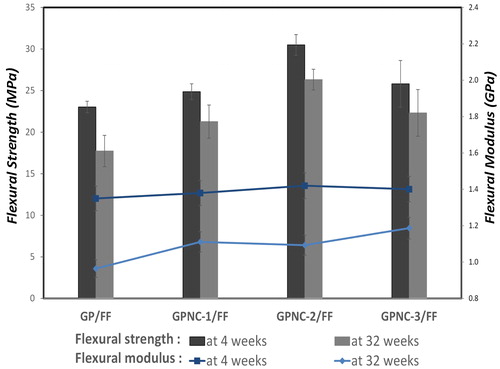
4 Conclusions
Geopolymer composites and nanocomposites reinforced with flax fabric (FF) and nanoclay (NC) have been fabricated and characterized. The effect of NC on the durability of FF reinforced geopolymer nanocomposites and the degradation of FF is reported. The optimum content of NC was 2.0 wt.%. After 32 weeks, the flexural strength of GP/FF composites decreased by 23.01% whereas flexural strength of GPNC-2/FF nanocomposites decreased by only 13.7%. SEM micrographs indicated that flax fibres in GP/FF composites suffer more degradation than that in GPNC-2/FF nanocomposites. Based on these observations, the addition of NC has great potential in improving the durability of flax fabric reinforced geopolymer nanocomposites during ageing.
Acknowledgement
The authors would like to thank Ms. E. Miller from the Department of Applied Physics at Curtin University for the assistance with SEM.
References
- M.AlzeerK.MacKenzieAppl. Clay Sci.75–762013148152
- V.ZivicaM.T.PalouT.I.Ľ. BágeľComposites B572014155165
- J.DavidovitsJ. Therm. Anal.378199116331656
- Y.QingZ.ZenanK.DeyuC.RongshenConstr. Build. Mater.2132007539545
- F.U.A.ShaikhS.W.M.SupitConstr. Build. Mater.702014309321
- A.NazariJ.G.SanjayanMeasurement602015240246
- T.Phoo-ngernkhamP.ChindaprasirtV.SataS.HanjitsuwanS.HatanakaMater. Des.5520145865
- M.SaafiK.AndrewP.L.TangD.McGhonS.TaylorM.RahmanS.YangX.ZhouConstr. Build. Mater.4920134655
- J.WeiC.MeyerJ. Mater. Sci.4921201476047619
- N.FarzadniaA.A.Abang AliR.DemirbogaM.P.AnwarCem. Concr. Res.48201397104
- H.AssaediF.U.A.ShaikhI.M.LowJ. Asian Ceram. Soc.420161928
- T.LinD.JiaP.HeM.WangD.LiangMater. Sci. Eng. A4972008181185
- T.AlomayriF.U.A.ShaikhI.M.LowComposites B6020143642
- P.J.Herrera-FrancoA.Valadez-GonzálezComposites B362005597608
- H.BohlooliA.NazariG.KhalajM.M.KaykhaS.RiahiComposites B43201212931301
- T.AlomayriF.U.A.ShaikhI.M.LowComposites B50201316
- T.AlomayriF.U.A.ShaikhI.M.LowJ. Mater. Sci.48201367466752
- M.AlzeerK.D.MacKenzieJ. Mater. Sci.47201269586965
- H.AssaediT.AlomayriF.U.A.ShaikhI.M.LowJ. Adv. Ceram.42015272281
- H.AssaediF.U.A.ShaikhI.M.LowComposites B952016412422
- M.AlyM.S.J.HashmiA.G.OlabiM.MesseiryA.I.HussainE.F.AbadirJ. Eng. Appl. Sci.620111928
- L.YanN.ChouwConstr. Build. Mater.992015118127
- A.HakamyF.U.A.ShaikhI.M.LowMater. Des.922016659666
- H.E.GramNordic Concr. Res.519836271
- V.VelpariB.E.RamachandranT.A.BhaskaranB.C.PaiN.BalasubramanianJ. Mater. Sci.15198015791584
- ASTM C-20Standard Test Methods for Apparent Porosity, Water Absorption, Apparent Specific Gravity and Bulk Density of Burned Refractory Brick and Shapes by Boiling Water2010
- I.M.LowM.McGrathD.LawrenceP.SchmidtJ.LaneB.A.LatellaK.S.SimComposites A382007963974
- A.HakamyF.U.A.ShaikhI.M.LowComposites B782015174184
- D.ZaharakiK.KomnitsasV.PerdikatsisJ. Mater. Sci.45201027152724
- T.BakharevCem. Concr. Res.36200611341147
- J.W.PhairJ.S.J.Van DeventerInt. J. Miner. Process.662002121143
- Q.LiH.XuF.LiP.LiL.ShenJ.ZhaiFuel972012366372
- P.ChindaprasirtC.JaturapitakkulW.ChaleeU.RattanasakWaste Manage.292009539543
- U.RattanasakP.ChindaprasirtMiner. Eng.22200910731078
- E.ul HaqS.Kunjalukkal PadmanabhanA.LicciulliCeram. Int.40201429652971
- Y.J.ZhangY.C.WangD.L.XuS.LiMater. Sci. Eng.527201065746580
- M.M.YadollahiA.BenliR.DemirboğaConstr. Build. Mater.942015767774
- B.J.MohrJ.J.BiernackiK.E.KurtisCem. Concr. Res.37200715311543
- F.Pacheco-TorgalS.JalaliConstr. Build. Mater.252011575581
- J.D.A.M.FilhoF.D.A.SilvaR.D.Toledo FilhoCem. Concr. Compos.4020133039
- A.BenturS.MindessFibre Reinforced Cementitious Composites2nd ed.2007Taylor & FrancisLondon and New York


